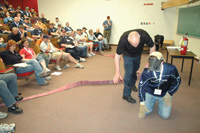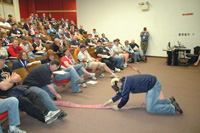
Equipment
Trainer’s Corner: August 2010
This Trainer’s Corner column is a collection of training drills that we at Canwest Fire have used to get firefighters more comfortable while wearing SCBA in immediately dangerous to life and health (IDLH) environments. You are welcome to change them to fit your department’s training guidelines.
August 9, 2010
By Ed Brouwer
This Trainer’s Corner column is a collection of training drills that we at Canwest Fire have used to get firefighters more comfortable while wearing SCBA in immediately dangerous to life and health (IDLH) environments. You are welcome to change them to fit your department’s training guidelines.
■ SCBA poker
- This is a timed event. (The timer is the low-air alarm.)
- Objectives: To get firefighters into the habit of checking their air pressure; to familiarize firefighters with search techniques while in an IDLH environment.
- Props: A deck of ordinary playing cards.
- Drill: Place obstacles such as chairs, tables and big cardboard boxes in your bay or a similar area. Shuffle the deck of cards and hide single cards face down throughout the search room. Divide firefighters into teams of two. Bleed down BA tanks to about half of their capacity – be sure they are all the same. Do not black out masks; however, if you have access to a smoke machine, use it. Otherwise, turn the lights off inside the building and allow firefighters to use flashlights. (Try placing waxed paper over the lens of the flashlight – it defuses the light to give a light smoke effect.) Each team gets one chance to go into the search area. They are to find five cards that make up a good poker hand. They do not have to take every card they find; they can gamble by leaving a card and hoping to find a better one. They must put the discarded card back, face down, exactly where they found it. When they are satisfied with their five cards they are to call the IC and inform him that they are leaving the building. Once every team has gone through the search room, the hands are revealed and the best poker hand wins. You can come up with prizes if you wish.
- There is, however, a disqualifier. Should the low-air alarm go off before the search team has exited the search room that team is disqualified and any cards they have are deemed of no value.
  |
|
| Trainer Ed Brouwer puts Dwayne Symes of the Ross Ferry Volunteer Fire Department in Nova Scotia through the paces in the mayday challenge during FDIC Atlantic in Wolfville, N.S., in June. PHOTOS BY LAURA KING |
■ PASS device search
- This is a timed event. (Use a stopwatch.)
- Objectives: To get firefighters into the habit of checking their air pressure; to familiarize firefighters with search techniques while in an IDLH environment.
- Props: A PASS device and a smoke detector.
- Drill: Place obstacles such as chairs, tables and big cardboard boxes in your bay or a similar area. Hide a PASS device and a smoke detector among the obstacles. Divide firefighters into teams of two. Black out masks (zero visability). Each team takes a turn going into the search area. Team members are to find the activated PASS alarm. Time starts when the team makes entry. Watch to see if they look behind the entry door or at least look a few feet in the opposite direction of their search. Once the door is closed behind them activate the smoke detector; 60 seconds later activate the PASS device. Time stops when the team deactivates the PASS device. The best time wins.
- There are two penalties and one disqualifier. A three-minute penalty is awarded for not checking behind the entry door. A two-minute penalty is awarded for not informing the IC that the PASS device was found. Should the low-air alarm go off before the search team exits the search room, that team is disqualified.
■ Mayday challenge
- This is NOT a timed event.
- Points are awarded for following mayday protocols (possible 100 points).
- Objective: To determine if firefighters will call a mayday for themselves.
- Scenario: Firefighters are sent in one at a time. BA masks are blacked out. The conditions in this scenario are immediately dangerous to life and health (IDLH), cold smoke and zero visibility. Radios are assigned. The firefighter is led into the building and brought to within five feet of the simulated charged hose line. As the firefighter is spun around, he is informed that he was part of a two-man attack team. The firefighter has lost connection with the hose and is now within five feet of the hose. The team was instructed to get out alive . . .
■ POINTS
- 5 – Firefighter calls out to the crew from which he/she was separated.
- 5 – Firefighter radios IC to inform of separation from hose.
- 10 – Firefighter radios a mayday and activates PASS if he can’t find the hose within 60 seconds.
- 10 – Firefighter uses L.U.N.A.R. or L.I.P.
- 5 – Firefighter radios IC to inform if he has found the hose.
- 5 – Firefighter radios IC to inform if he is following the hose line.
- 5 – Firefighter notes the couplings and follows hose line to safety.
- 5 – Firefighter radios IC to inform if/when low-air alarm is activated. 10 – Firefighter radios a mayday after low-air alarm activation if not able to exit in 60 seconds.
- 10 – Firefighter uses L.U.N.A.R. or L.I.P.
- 5 – Firefighter activates PASS alarm upon low-air alarm if not able to exit in 60 seconds.
- 5 – Firefighter calls out to partner when hears the PASS alarm activated.
- 10 – Firefighter radios a mayday for partner’s PASS alarm when activated.
- 10 – Firefighter uses L.U.N.A.R. or L.I.P.
- 100 – (L.U.N.A.R. = Location, Unit, Name, Assignment / Air, Resources needed; L.I.P. = Location, Identification, Problem)
I hope these drills will be of benefit to your department. As always, I am looking for ideas to make our training nights more effective. I would appreciate your input. You can e-mail me at ed@thefire.ca. Thanks for your contribution to firefighter safety.
Train like their lives depend on it.
Ed Brouwer is the chief instructor for Canwest Fire in
Osoyoos, B.C., and the training officer for West Boundary Highway
Rescue. The 19-year veteran of the fire service is also a fire warden
with the B.C. Ministry of Forests, a wildland interface fire
suppression instructor/evaluator and a fire-service chaplain. Contact
Ed at ed@thefire.ca
Print this page